Abstract
The main goal of the work was to create an internal coating based on super critical CO2 extracts of raspberry seeds, pomegranate seeds and rosemary that could be active against chosen bacterial strains. Additionally, the synergistic effect of these substances in the coating were then analysed. The next goal of the work was to demonstrate the antiviral activity of the coatings against phi6 bacteriophage particles (airborne viruses surrogate). The results of the study indicated that three coatings containing a mixture of extracts showed bacteriolytic activity against S. aureus cells and bacteriostatic activity against E. coli and B. subtilis strains. Two coatings showed bacteriolytic activity against a P. syringae strain. As a result of the experiments, a synergistic effect was noted in the active additives/compounds in the coatings. These coatings may be used as internal coatings for packaging films to extend the shelf life of selected food products. All seven coatings may also be used as external coatings with antiviral activity, as these coatings demonstrated significant effects on the phi6 phage, selected as a surrogate for airborne viruses, e.g., coronaviruses. It could be concluded that coatings I–VII will also show antiviral effects on SARS-CoV-2 particles.
1. Introduction
The incidences of bacterial antibiotic resistance, growing foodborne infection, and the emergence of new microorganism mutations are a global health hazard to people. Thus, the development of novel antibacterial packaging materials which are active against bacteria has become a top priority [1]. Interest in active food packaging has also been fuelled by increased consumer demand for safe, convenient, fresh-like foods with extended shelf life [1,2]. Active substances which are responsible for the antimicrobial activity of the packaging can be introduced into the polymer matrix or the coating. The active coatings are typically manufactured using biopolymers derived from various natural plant and animal sources, such as polysaccharides with the addition of other active substances [2,3,4]. An excellent example of the use of active packaging to extend the shelf-life of food products was offered by a previous work carried out by the author [3]. The study demonstrated that boxes containing polyethylene films (PE) coated with an active layer consisting of methyl-hydroxy-propyl-cellulose (MHPC) with nanoparticles of zinc oxide were found to be very active films to extend the shelf life of cod fillets. Another good example is a previous study by the author [4] which demonstrated that a PE covered with MHPC coating/layers with a very small amount of nanoparticles of zinc oxide, as well as geraniol or carvacrol, were found to be very good, active films to extend the shelf life of food products. Additionally, a synergistic effect between active additives/compounds mentioned above was also noticed. There are many substances, such as essential oils, ZnO nanoparticles or plant extracts which may be added into the coating carrier to create an active coating [1,2,3,4,5].
The health potential of pomegranate fruit and their extracts pertains to a wide spectrum of biological activity generally attributed to the high content of polyphenolic compounds, though no distinction is made between the various phenolics (hydrolysable tannins, anthocyanins and proanthocyanidins) [6]. Both the edible and non-edible parts (including leaves, roots, seeds, peelsand and bark) of the pomegranate have been demonstrated to have a wide spectrum of health benefits [7]. It was demonstrated by Hanafy et. al. [8] that methanolic and ethanolic extracts offered high antimicrobial activity against Bacillus cereus, S. aureus, Pseudomonas aeruginosa and Escherichia coli, and greater activity was obtained in the case of methanolic forms. The extraction of active substances from pomegranate by-products is usually carried out by maceration in aqueous and/or organic solvents, with occasional technological assistance through the use of ultrasound, high pressure or enzymes. Few studies have reported extraction by supercritical CO2 technology [6], which is an environmentally friendly technique used by de Silva et al. [9] for the extraction of bioactive substances from pomegranate peel. CO2 is one of the most popular solvents because it is non-toxic, cheap, readily available and generally recognized as safe (GRAS) [10,11]. The extract was found to be rich in phenolic substances, mainly in ellagitannins, as well as the high content of lipophilic compounds, such as tocopherols and β-carotene [9].
Rosemary plant extracts efficiently prevent lipid oxidation in various food products. The activity of rosemary extracts can be majorly attributed to rosmarinic acid, phenol diterpen, carnosol, carnosic acid [12], rosmanol, betulinic acid and ursolic acid [13]. A clear demonstration was made that they may prolong the shelf life of beef up to 15 days, rather than the current 5–6 days, due to their antimicrobial properties. Rosemary extracts are active against many bacterial and mould strains, such as Staphylococcus aureus, Listeria monocytogenes or Aspergillus parasiticus [12,13,14,15].
Berries contain many fibres, vitamins, phytochemicals, and minerals. The primary phytochemicals in berry fruits are phenolic substances, such as flavonoids (flavones, flavanols, anthocyanins, flavonols, isoflavonoids and flavanones), tannins, and phenolic acids. Since berries have a high amount of polyphenols, it is possible to use these compounds to obtain extracts with potential antimicrobial effects. The activity of raspberry extracts can be mainly attributed to polyphenols, anthocyanins (pelargonidin, cyanidin, peonidin, delphinidin, petunidin and malvidin), flavonols (quercetin, kaempferol and myricetin), hydroxycinnamic acids (caffeic, ferulic and p-coumaric acids), hydroxybenzoic acids (p-hydroxybenzoic and ellagic acids), hydroxycinnamic acids (ferulic, p-coumaric and caffeic acids), hydroxybenzoic acids (p-hydroxybenzoic and ellagic acids). Furthermore, proanthocyanidins from raspberries showed antibacterial, antiviral, anti-inflammatory, antioxidant, anti-carcinogenic and vasodilatory activity; ellagitannins from raspberries demonstrated anti-inflammatory, antioxidant, antimicrobial, anticarcinogenic and anti-Helicobacter pylori effect [16].
Rosemary plant extracts and raspberry and pomegranate fruit extracts which contain many of the active compounds mentioned above, were found to be active against viruses [17,18]. Rosmarinic acid from rosemary extracts showed inhibitory effects on SARS-CoV-2 [17]. Ellagic acid from raspberry and pomegranate demonstrated activity against hepatitis A, hepatitis B and the Dengue virus. Luteolin from rosemary showed activity against HSV-1 and HSV-2. Kaempferol from berry fruits was found to be active against coronaviruses [18].
Supercritical CO2 extracts of red Araca showed inhibitory effects on Gram-positive bacteria S. aureus (SA) and L. monocytogenes (LM) [19]. The antibacterial action of supercritical extracts (thyme, oregano, hop, rosemary, basil and cloves) against pathogenic bacteria, such as S. aureus, B. subtilis, and L. monocytogenes was investigated by Bhavya M.L. [20]. The authors confirmed that these extracts were very active against the bacteria analysed.
Supercritical CO2 extracts are also active against many bacterial strains. They can be added into a coating carrier as active substances to get active coatings. If the packaging material is coated with an internal coating with antimicrobial properties, it can be used to protect food products and increase shelf life. It is also possible to cover packaging with an external, active layer with antibacterial and antiviral properties.
The global spread of the pandemic caused by SARS-CoV-2, which causes severe acute respiratory syndrome (SARS), poses a high risk to the health of men and women and the economy. To prevent the transmission of the SARS-CoV-2 particles, the use of medical masks and gloves by medical staff and health workers, and by the general population, has become essential. Another prevention measure is the regular disinfection of hands in public places, though this may lead to the spread of resistant bacteria and virus particles via human hands. Additionally, it is not possible to disinfect every single piece of food packaging or area after being touched by the public. Safety concerns related to shopping in supermarkets during the COVID-19 pandemic have led to a selection of single-use food packaging and synthetic polymer bags to carry food products. In order to address customer worries and make them safe, supermarkets may develop additional health safety measures, e.g., film/paper/cardboard bags with antiviral properties. This proper packaging must have an internal coating to preserve food products against microbiological spoilage and an external coating with antiviral properties to protect customers hands.
It is known that users of public institutions, such as offices, schools, shops, cinemas and theatres can contribute to the spread of SARS-CoV-2 virus and bacteria through different surfaces that they come into contact with that have not been disinfected or washed. During the pandemic, most surfaces are disinfected or irradiated with UV radiation. Unfortunately, these surfaces cannot be irradiated or disinfected after every touch by the public. A polymer film with an external coating with antiviral and antibacterial properties could be successfully used to cover locations that are exposed to a frequent touch, e.g., doors, switches, elevator buttons, etc. The film covered by the active coating can then be regularly changed, meaning there will then be no need for the frequent disinfection of selected surfaces [4].
The initial purpose of the study was to obtain an internal coating based on super critical CO2 extracts of the selected fruits (raspberry and pomegranate seeds) and of the chosen herb (rosemary) that could be active against bacterial strains responsible for food spoilage. Additionally, the synergistic effect of the selected compounds in the coating was tested. An additional goal of the work was to show the antiviral effect of the coatings against phi6 bacteriophage (used as an eucaryotic virus surrogate).
Based on the results of the author’s previous study [4], testing the antiviral properties of the coatings was to be performed using phi6 bacteriophage which represents a good surrogate for the work of airborne viruses, such as influenza viruses and coronaviruses including SARS-CoV-2 [4,21].
2. Materials and Methods
2.1. Materials
The test microorganisms used to perform these experiments were purchased from a collection from the Leibniz Institute DSMZ (Deutsche Sammlung von Mikroorganismen und Zellkulturen). The bacterial strains used in this work were E. coli DSMZ 498, S. aureus strain DSMZ 346, P. syringae van Hall 1902 DSM 21482 and B. subtilis DSMZ 1090. Phage phi6 DSM-21518 was used as a SARS-CoV-2 surrogate.
Polyethylene films, (A4, 50 μm) (KB FOLIE) were used to perform the experiments. Methyl-hydroxy-propyl-cellulose (MHPC, Chempur, Piekary Śląskie, Poland) was used as carrier to cover the films. Ecological CO2 extracts (ECOSPA, Józefosław, Poland) of a. raspberry seeds, b. rosemary, and c. pomegranate seeds were used as active substances. Decyl Glucoside and Caprylyl/Capryl glucoside (Greenaction Sp. z o.o., Kielce, Poland) were used as emulsifiers. To verify the antibacterial and antiviral properties of the coatings, MacConkey agar (Merck, Darmstadt, Germany), TSB, TSA and Luria–Bertani (LB) broth (BIOMAXIMA, Lublin, Poland) were used. All mediums were prepared according to BIOMAXIMA and Merck protocols which means that all mediums were weighed, suspended in 1000 mL of distilled water, and autoclaved at 121 °C for 15 min (according to manufacturer’s instructions).
2.2. Coating Preparation
The coating carriers containing active substances were prepared according to protocols used in previous studies [3,4]. The following experiments were carried out:
- (1)
- An amount of 12 g of MHPC was introduced into the baker containing 288 mL of distilled water. The mixture was stirred for 1 h using a magnetic stirrer (Ika, Warsaw, Poland) at 1500 rpm.
- (2)
- An amount of 2 g of CO2 extract of raspberry seeds (I), pomegranate seeds (II), and rosemary (III) were introduced into beakers separately. Then, 1 g of Decyl Glucoside and 1 g of Caprylyl/Capryl glucoside were introduced into each beaker and mixed for 10 min using a magnetic stirrer at 500 rpm (Ika, Warsaw, Poland). As a next step, 36 g of 4% MHPC was introduced into each mixture. Mixtures I, II, and III were mixed for 15 min (separately) using a magnetic stirrer (Ika, Warsaw, Poland) at 1000 rpm.
- (3)
- An amount of 1 g of CO2 extract of raspberry seeds and 1 g of CO2 extract of pomegranate seeds (IV) were introduced into the first beaker; 1 g of CO2 extract of raspberry seeds and 1 g of CO2 extract of rosemary (V) were introduced into the second beaker; 1 g of CO2 extract of pomegranate seeds, and 1 g of rosemary (VI) were introduced into the third beaker. These were mixed for 5 min using a magnetic stirrer at 500 rpm (Ika, Warsaw, Poland). Then, 1 g of Decyl Glucoside and 1 g of Caprylyl/Capryl glucoside were introduced into each beaker and mixed for 10 min using a magnetic stirrer at 500 rpm (Ika, Warsaw, Poland). As a next step, 36 g of 4% MHPC was introduced into each mixture. The mixtures IV, V, and VI were also mixed for 15 min (separately, at 1000 rpm).
- (4)
- An amount of 0.7 g of CO2 extract of raspberry seeds, 0.7 g of rosemary and 0.7 g of CO2 extract of pomegranate seeds (VII) were introduced into the beaker; this was mixed for 5 min using a magnetic stirrer at 500 rpm (Ika, Warsaw, Poland). Then, 1 g of Decyl Glucoside and 1 g of Caprylyl/Capryl glucoside were introduced into the beaker and mixed for 10 min using a magnetic stirrer at 500 rpm (Ika, Warsaw, Poland). Next, 36 g of 4% MHPC was introduced into the mixture. Mixture VII was also mixed for 15 min at 1000 rpm.
Polyethylene (PE) foils were coated using Unicoater 409 (Erichsen, Hemer, Germany) at a room temp. of 25 °C. The coatings were dried for 10 min at a temperature of 50 °C. The thickness of each coating was 1.5 µm. PE foils that were not covered were control samples (K).
The PE foil samples were then cut into square shapes (3 cm × 3 cm) and used in the antimicrobial properties analysis. Active coatings were marked with Roman numerals. Sample designations are given in the Table 1.

Table 1.
Descriptions of the samples.
2.3. Antibacterial Properties Analysis
The antibacterial effect of the obtained coatings against B. subtilis, S. aureus, P. syringae and E. coli strains, compared to the non-covered foil samples, was performed according to the ASTM E 2180-01 standard [22].
2.4. Antiviral Properties Analysis
As a first step of the antiviral properties analysis, the phage phi6 was purified based on the method of Bhetwal et al. [23]. The bacteriophage lysate was then prepared according to Bonilla et al. [24]. The antiviral effects of the covered foil samples were compared to the non-covered foil samples and were performed according to a modified ISO 22196-2011 standard [4,25].
To evaluate the phi6 host growth rate in real time, after P. syringae incubation with the active layers/coatings (I, II, III, IV, V, VI and VII), phage lysate was incubated with the covered foil samples (each active coated film separately) according to the ISO 22196-2011 standard, while bacteriophage lysate was incubated with polyethylene samples devoid of coating at the same time. The LB broth was added into five Biosan bioreactors (BS-010160-A04, Biosan, Riga, Latvia). The overnight bacterial culture was then added to 30 mL of LB broth and incubated at 28 °C until OD = 0.2 (optical density). Five phi6 bacteriophage lysates were amplified in respective host bacteria (one lysate—after incubation with a PE foil sample, control sample, four phage lysates separately—after their incubation with coatings/layers I, II, III, IV). Next, 11 µL of phi6 lysate (MOI = 1, 1 phage per 1 bacterial cell) was introduced to a P. syringae culture (OD = 0.2) and incubated for 24 h at 28 °C. Five tests were performed simultaneously, and it was possible to evaluate four active layers during these tests. The antiviral effect of coatings V, VI and VII was evaluated in the next experiment according to the methods described above.
2.5. SEM
The coatings/layers were analysed using a scanning electron microscope (SEM). A microscopic analysis was carried out using a Vega 3 LMU microscope (Tescan, Brno-Kohoutovice, Czech Republic). The experiments were important to determine if the coatings were homogeneous or not. A test was performed at 25 °C with a tungsten filament and an accelerating voltage of 10 kV was used to capture SEM images for both the non-coated and coated PE foil samples. All specimens were viewed from above. An analysis was performed based on a protocol from a previous study [26].
2.6. Statistical Analysis
Statistical significance was evaluated using an analysis of variance (One-way ANOVA). The number of treatments (n) was 8. The values were considered significantly different when p < 0.05 (*); p < 0.01 (**); p < 0.001 (***); p < 0.0001 (****). All analyses were evaluated with GraphPad Prism 8 (GraphPad Software, San Diego, CA, USA).
3. Results
3.1. Antibacterial Properties Analysis
The results of the work showed that coatings III, V, VI and VII inhibited the growth of S. aureus cells completely (Figure 1). All of these coatings contained a CO2 rosemary extract. Coating III only contained rosemary extract as an active compound. In the case of an MHPC coating containing CO2 raspberry seed extract as an active compound (I), the inhibition of bacteria growth was not observed, but the amount of Gram-positive bacteria decreased when compared to the non-coated PF films (control sample K) (Figure 1). A decrease in the number of the S. aureus cells was observed from 9.4 × 107 to 1.23 × 106 (CFU/mL). Similar results were obtained in the case of a films coated with the layers containing the CO2 extract of pomegranate seeds. The addition of this extract to the MHPC carrier had an impact on the antibacterial effect of the coating against S. aureus. The number of microorganism cells decreased from 9.4 × 107 to 1.3 × 106 (CFU/mL). Statistical analysis demonstrated that changes in the number of S. aureus cells were significant (p < 0.0001).
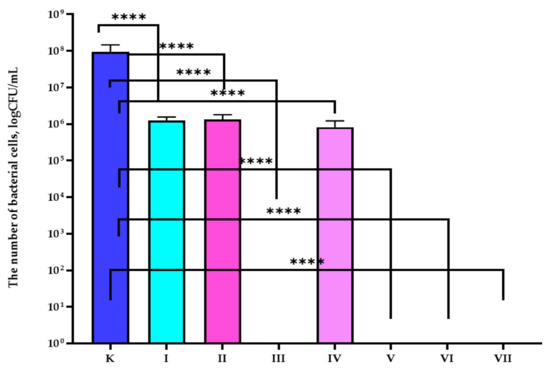
Figure 1.
The influence of coated, active films on S. aureus growth. One-way ANOVA test: ****—p < 0.0001.
The results of this research demonstrated that active layers obtained by the addition of a mixture of raspberry and pomegranate seed extracts were also found to be active against this microorganism. These coatings decreased the growth of the bacterial cells from 9.4 × 107 to 8.25 × 105 (CFU/mL). The differences between the numbers of viable S. aureus cells were significant, as confirmed by a one-way ANNOVA test (p < 0.0001). To summarise, it may be assumed that the III, V, VI and VII coatings/layers demonstrated very high activity against S. aureus cells, resulting in a complete inhibition of any active bacterial cell.
It was shown that all of the coatings containing pure CO2 extracts and their mixtures as active compounds did not inhibit the growth of E. coli, but decreased the amount of microorganism cells. As emphasised below (Figure 2), the statistically significant antibacterial activity of I and II coatings was noted. Similarly, the III coating demonstrated a 1 log reduction in the number of E. coli cells. The results confirmed that mixtures of two of the three extracts in the coating caused a 1 log reduction in the amount of microorganisms. Statistical analysis determined that the differences between numbers of E. coli cells were significant (p < 0.001). Figure 2 demonstrated that coating VII also decreased the number of Gram-negative bacteria (2 log). When comparing the antibacterial effect of coatings I–VI and coating VII, the highest activity was observed in the case of coating VII. To summarise, it should be noted that the coatings I–VI showed low and coating VII showed moderate activity against E. coli, resulting from a bacteriostatic effect, though devoid of a bacteriolytic effect.
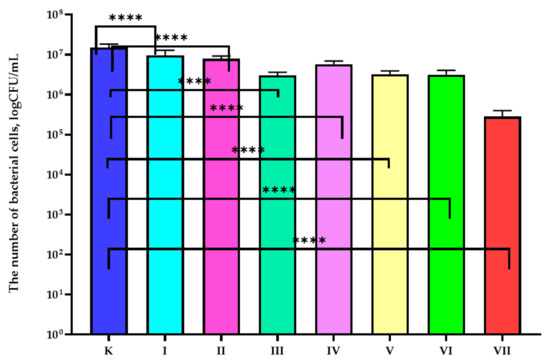
Figure 2.
The influence of coated, active films on E. coli growth. One-way ANOVA test: ****—p < 0.0001.
It was shown in this work that coatings II and IV did not reduce the number of the P. syringae cells. As emphasised below (Figure 3), the influence of coating I on the growth of bacterial cells was noted as not significant. PE foil samples coated with the MHPC layer containing CO2 rosemary extract as an active compound (III coating) and PE foil samples coated with the layer containing a mixture of CO2 extracts of pomegranate seeds and rosemary caused a 1 log reduction in the number of bacterial cells. As seen in Figure 3, a complete inhibition in the number of P. syringae was noticed for coatings V and VII. As indicated by statistical analysis (Figure 3), the impact of active coatings II, III, V, VI, and VII on the number of microorganism cells was significant. To summarise, it may be stated that coatings V and VII showed very high activity against P. syringae cells, resulting from a complete inhibition of bacterial growth.
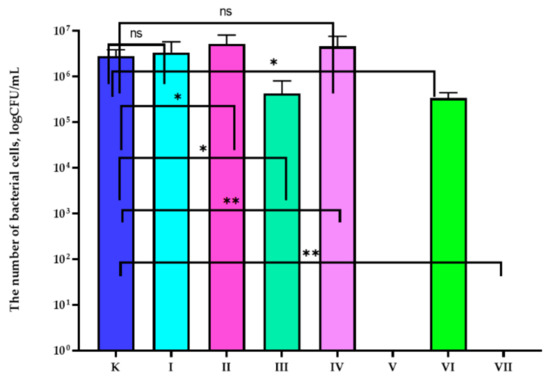
Figure 3.
The influence of coated, active films on P. syringae growth. One-way ANOVA test: p < 0.001; **—p < 0.01; *—p < 0.05; ns—not significant.
The results of the study showed that all of the active layers containing pure CO2 extracts and their mixtures as active substances did not inhibit the growth of B. subtilis, but decreased the number of microorganism cells. As demonstrated below (Figure 4), the statistically significant antibacterial activity of coatings II–VI and VII was noted. In the case of these coatings, a small (1 log) reduction in the amount of B. subtilis was noticed. The results confirmed that the coating containing CO2 raspberry seed extract as an active substance caused a 2 log reduction in the number of viable microorganism cells. A statistical analysis (Figure 4) determined that the differences between numbers of B. subtilis viable cells incubated with the active coatings were significant compared to the PE foil samples devoid of coatings (K). Summarising, it can be said that coatings II–VII showed low, and coating I showed moderate activity against B. subtilis, resulting from the 1 log-2 log reduction in the number B. subtilis, devoid of a complete inhibition in the growth of the microorganism.
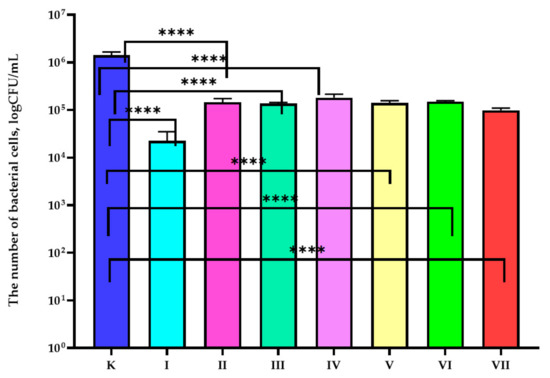
Figure 4.
The influence of coated, active films on B. subtilis growth. One-way ANOVA test: ****—p < 0.0001.
3.2. Antiviral Properties Analysis
With an evaluation of the growth rate in real time, the OD of the P. syringae over time, cultivated with phi6 after its incubation with coated and uncoated PE foils samples was carried out to demonstrate the antiviral effect of the active layers. Figure 5 determines the OD over time of the host cultivation at 28 °C. An evaluation of the OD over time of the P. syringae culture incubated with the phi6 particles (after the incubation of the phi6 particles with the PE foil samples (K)) was performed and an OD fall was noticed after 12 h of phi6 cultivation with the host strain, which demonstrated that phi6 bacteriophage inhibited most of the microorganism cells. This clearly shows that PE devoid of coating (control sample) was not active against phi6 phages, and this result was confirmed by an experiment which was performed according to a modified ISO 22196-2011 standard. The results of this experiment demonstrated (Figure 6, Table 2) that the number of the phi6 phages after their incubation with the PE films was 3.57 × 108 [PFU/mL].
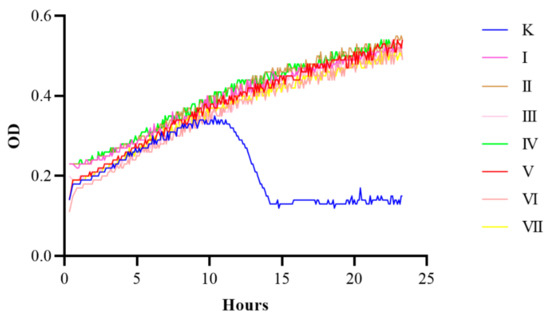
Figure 5.
OD over time for P. syringe incubated with phi6 phages after their incubation with the chosen coatings (phages were added when OD = 0.2, amount of phage MOI = 1).
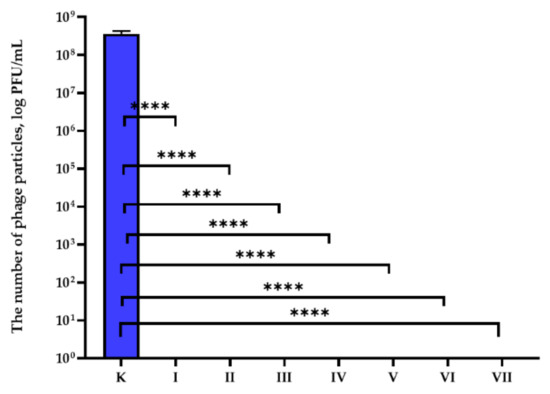
Figure 6.
The influence of coated, active films on bacteriophage titer. One-way ANOVA: ****—p < 0.0001.

Table 2.
The influence of coated, active films on bacteriophage titer.
The results of the work illustrate (Figure 5) that the incubation of the phi6 bacteriophages with the I–VII active layers completely inactivated the bacteriophage particles. An evaluation of the OD over time of the P. syringae strain cultivated with the phi6 particles (after the incubation of the phi6 particles with PE foil samples coated with the active layers, respectively: I–VII separately) was carried out and an OD fall was not noted after 24 h of phage cultivation with the host culture (Figure 5), which showed that phi6 bacteriophage did not eliminate any of the bacterial cells. These results proved that the phages were not active after their incubation with all of the active coatings. The antiviral properties of all of the described coatings were confirmed using a modified ISO 22196-2011 standard. As emphasized in Figure 6 and Table 2, the number of the phi6 particles after their incubation with each film coated with the active layer was found to be zero, meaning that phages did not reduce the number of host cells. To summarise, it can be assumed that all of the analysed coatings showed very high antiviral activity.
3.3. SEM Analysis
All of the coatings that were obtained were smooth and transparent. The addition of a mixture of emulsifiers made this possible. Figure 7 shows pictures of coatings V and VII, which were highly active against the largest number of tested bacterial strains and phi6 phage particles. On the other hand, a SEM analysis demonstrated that the coatings were not homogeneous. As shown in Figure 8 (SEM images in magnification of 1000× and 3000×) and in Supplementary Materials (SEM images in higher magnification), the hydrophobic molecules of the active substances were visible in the hydrophilic carrier. The molecules were spherical (marked with a blue arrow) and elliptical in shape (marked with a pink arrow). The molecules which were irregular in shape (marked with a red arrow) were also observed. The particle distribution was also irregular. As shown in Figure 8, holes (marked with green arrows) in the coatings were also observed, which confirmed that extract particles had been released from the coating. The release of active compounds from the coatings may lead to a decrease in the activity of the coatings. Comparing coatings I–VII led to the observation that the coatings that consisted of coating carrier with mixtures of CO2 extracts of raspberry seeds, pomegranate seeds and rosemary contained more spherical molecules than coatings with the addition of one extract. Moreover, the active particles of the active substances from coatings IV–VII were of smaller size to the antimicrobial molecules of coatings I–III.
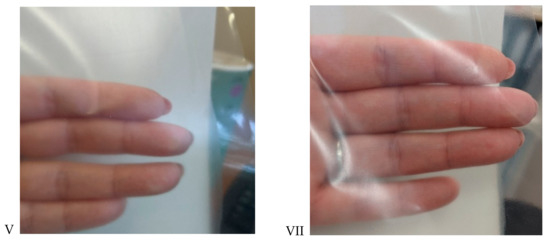
Figure 7.
The images of the V coating containing a mixture of CO2 extracts of raspberry seeds and of rosemary and the VII coating containing a mixture of CO2 extracts of raspberry seeds, of pomegranate seeds and of rosemary.
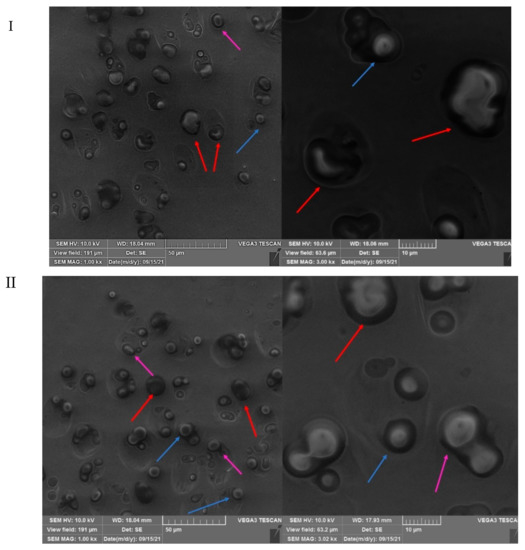
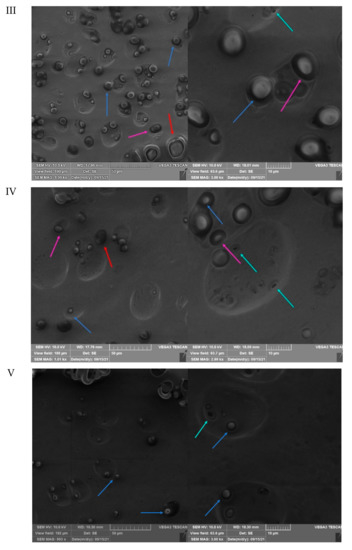
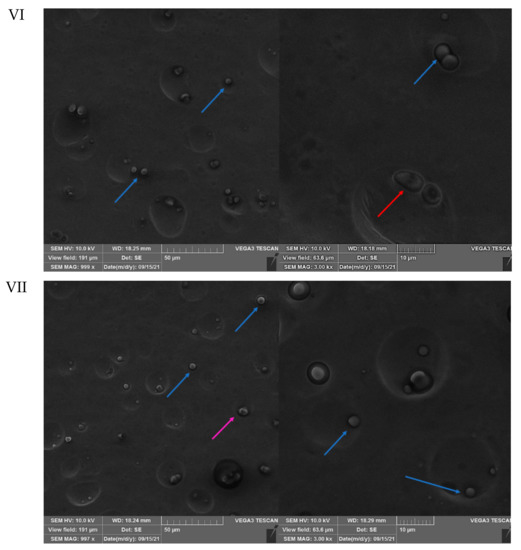
Figure 8.
The SEM images the active coatings (I–VII).
4. Discussion
During the current COVID-19 pandemic, demand for disposable polymer packaging is expected to increase by 40% [27]. Consumers and providers want to be safe, which has led to the use of food products introduced in disposable paper and foil packaging to avoid the food contamination of various food products [3,4,27]. Additionally, food producers would like to extend the freshness and quality of food in packaging. Polymer films or paper coverings with active, internal layer/coatings may be a good solution to the problem, but only if the antimicrobial effect of these layers is high [3,4]. Bhavya et al. [20] confirmed that a super critical CO2 rosemary extract was active against S. aureus and L. monocytogenes strains. Due to the high activity of the extract, it was chosen as an active compound and was added into the coating carrier. The results of the work indicated that the coating with a rosemary extract showed bacteriolitic activity against S. aureus. The presence of phenol diterpens, carnosol or carnasoic acid [12,13] in the rosemary extract could be the cause of the complete inhibition in the growth the bacterium. The most likely antibacterial action mechanisms of these compounds were efflux pump inhibition or bacterial cell membrane and an increase in cell wall permeability [28]. It was observed that the coating decreased the number of E. coli, B. subtilis and P. syringae cells despite the pure extract (not in the coating) not being active against E. coli and B. subtilis [20]. Disturbance in protein and DNA metabolism by diterpens from the extract could have caused bacteriostatic activity [28].
As a result of the study, a decrease in the antimicrobial effect of the coatings against Gram-negative bacteria and against Gram-positive bacteria was noted, if the active layers contained super critical CO2 extracts of raspberry seeds or pomegranate seeds, rather than a rosemary extract. These extracts as the active substances in coatings showed low activity against all of the analysed bacterial cells compared to the coating with rosemary extract. Contrary results were found by Hanafy S.M. et al. [8], who demonstrated that pomegranate extracts may be highly active against B. cereus, S. aureus, P. aeruginosa and E. coli strains. The high activity of these extracts may be explained simply by their chemical composition. According to Golovinskaia et al. [16], raspberry extracts should contain polyphenols, anthocyanins and flavonols. According to Harscoat-Schiavo et al. [6], pomegranate extracts should include anthocyanins, proanthocyanidins and hydrolysable tannins. Alvarez-Martínez et al. [28] demonstrated that the most common antimicrobial action mechanisms of these compounds are those related to a bacteriolytic type. Among these compounds, terpenes were found to be the most abundant antimicrobial forms, followed by polyphenols. These two chemical classes have been associated with remarkably similar action mechanisms, mainly based on the disruption of the bacterial plasma membrane, which is highly active against B. cereus, S. aureus, P. aeruginosa and E. coli. The results shown in this paper are not comparable with those shown by Hanafy et al. [8].
The coating (IV) containing a mixture of two extracts (CO2 extract of pomegranate seeds and raspberry seeds) showed bacteriostatic activity against B. subtilis and S. aureus belonging to Gram-positive bacteria, and Gram-negative bacteria, such as E. coli, but had no influence on the growth of P. syringae. Additionally, the synergistic effect between pomegranate seed extracts and raspberry seed extracts reported above was not noted because the increase in the activity of the coating containing the mixture of these two extracts compared to the activity of the coatings containing pure extracts (introduced separately) was not observed. In the case of the mixtures of CO2 extracts, the addition of a rosemary extract to the coating carrier had an impact on the increase in the coatings’ antimicrobial effectiveness. Coatings V and VI, that contained a rosemary extract mixed with raspberry (V) or pomegranate seed extract (VI), were found to be very effective, proving that there is a synergism between these active compounds. In the case of S. aureus, layers V and VI demonstrated bacteriolytic effect that must have been caused by the rosemary extract. The same coatings (V and VI) demonstrated bacteriostatic activity against the E. coli strain. Results which proved inverse results were noted by Sharma et al. [29] whose layers exhibited greater antimicrobial effect on E. coli bacterium than on S. aureus. In the case of the P. syringae strain, coating V showed bacteriolytic activity, while coating VI demonstrated bacteriostatic activity. This means that there is a greater synergistic effect between the raspberry seed extract and the rosemary extract than between the extracts of pomegranate seed and rosemary. This could be explained by the chemical composition of the mixture of the extracts. These mixtures contain active substances from both extracts. The rosemary extract should include ursolic acid [12,13] and the raspberry extract should contain tannins [16]. Alvarez-Martínez et al. [28] proved that tannins and ursolic acid revealed multifactorial activity, rather than one activity mechanism, with pleiotropic effects at various levels also being observed. It could be assumed that mixture V contained a high amount of tannins and ursolic acid which demonstrated multifactorial, antimicrobial activity, resulting in a synergistic effect between these two extracts.
The most effective results were obtained for coating VII, which contained the mixture of all three extracts described above, proving a synergistic effect between them. This effect also could have also been caused by multifactoral activity. To summarise, polyethylene foil samples coated by an internal MHPC coating/layer with a mixture of two or three extracts (mentioned above) or an internal MHPC coating/layer with rosemary extract were found to be promising packaging films to extend the shelf life of selected food. The results demonstrated here are comparable with those reported by Zhu [30], who indicated that films containing sea buckthorn pomace extract inhibited the growth of bacteria including L. monocytogenes, E. coli, Salmonella spp. and S. aureus, improving the quality of beef jerky products. The author also noted that active films containing thinned young apple extract, due to their antimicrobial properties, improved the quality of carp fillets.
Phi6 is a dsRNA bacteriophage of the Cystoviridae family that has been suggested as a good surrogate for the analysis of enveloped RNA viruses, including SARS coronaviruses. This phage is similar to SARS-CoV-2, it is enveloped by a lipid membrane, has spike proteins and is of a similar size (~80–100 nm) [31]. That is the reason why it may be assumed that the substances which are active against phage phi6 will be also active against SARS-CoV-2. Considering potential targets to inactivate particles of a virus with an active substance, they can be distinguished as either nucleic acids, proteins (capsid proteins, membrane proteins) or the envelope membrane. Polyphenols, such as flavonoids, tannins and rosmarinic acid, carry several phenolic OH groups. Mentioned above, OH groups may form hydrogen and ion bonds containing outer groups of proteins, e.g., positively charged amino groups. When tannins or phenols are incubated with virus particles, polyphenolic compounds bind to viral proteins in the envelope, that often prevents docking of the virus to host cells. Thus, many polyphenolic compounds may be said to be antiviral. It should be underlined that these compounds have antiviral activity against free viral particles but not—or to a lesser degree—after a virus has entered a host cell [32]. The results of the study demonstrated that active coatings I–VII inactivated the bacteriophage particles completely, which proved that the antiviral properties of the coated PE films was very high. It can be assumed that polyphenols, rosmarinic acid or tannins from extracts of rosemary, raspberry and pomegranate seeds inactivated phi6 particles. It may be concluded that coatings I–VII, which inactivate phi6 bacteriophage particles, would be also effective against eukaryotic SARS-CoV-2. Pan et al. has noted that phages can be used as surrogates for eukaryotic viruses [33]. A more precise suggestion was made by Prussin II [21], who clearly indicated that the phi6 phage particles may be selected as a surrogate for coronaviruses. These assumptions were confirmed by Surucic et al. [34] who indicated that pomegranate polyphenolic compounds have the potential to attenuate the ability of SARS-CoV-2 S-glycoprotein to bind to the ACE2 receptor and therefore to be excellent candidates for possible therapeutic application. It should be also mentioned that the authors suggest the possible synergistic effect of pomegranate polyphenols.
Comparing coatings I–VII with those described in the previous study [4], it should be mentioned that MHPC coatings containing the super critical CO2 extracts of raspberry seeds, pomegranate seeds, rosemary and their mixtures offered greater antiviral activity than the MHPC coatings containing ZnO nanoparticles, geraniol and carvacrol, despite the synergistic effect of nano ZnO, geraniol and carvacrol being observed. Only two (ZG1—MHPC layer with zinc oxide nanoparticles and geraniol; ZC1—MHPC layer with nano ZnO and carvacrol) of the seven coatings were active against phi6 phage, and the antiviral activity of these two coatings was moderate [4]. If consumers and producers believe that external coating should be active against bacteria and viruses, coatings III, V, VI and VII should be used as external coatings, but if they feel that the external coating should only be active against viruses, all seven coatings could be used externally to create single-use food packaging and plastic bags to carry groceries. The packaging materials coated with all of the coatings/layers described here (as external layers) could protect consumers and limit the spread of SARS-CoV-2, a very important point of concern for humans during the current pandemic.
5. Conclusions
Polyethylene foil samples coated with internal, MHPC coatings (V, VI, VII) with the addition of a mixture of extracts were found to be the most active foils which could be used to extend the shelf life of food products. All of the described layers (I–VII) could also be used as external coatings with antiviral activity, because these coatings/layers demonstrated a great influence on the activity of phi6 bacteriophage, selected as a surrogate for a novel coronavirus. It may be concluded that coatings I–VII will be also effective against SARS-CoV-2 particles, and it can offer the possibility to decrease its transmission through the use of coated foils and paper/cardboard. The safe packaging material should be covered with an internal layer to preserve food against microbiological spoilage and an external coating with antiviral activity to protect customers and providers. It should also be noted that consumers, as users of public institutions, such as shops, can contribute to the spread of SARS-CoV-2 virus and bacteria by touching different surfaces that cannot be disinfected after every touch. Coatings with high antiviral properties could also be used to cover areas which are exposed to frequent touch, e.g., doors, switches and elevator buttons, etc.
The mixture of the extracts could be introduced as an active additive into the selected polymer matrix to obtain granulate with antibacterial and antiviral properties. The granulate with antimicrobial properties could be used to create coatings and laminates during thermoplastic processing. It would also be possible to form elements and objects used in everyday life in public places/units, where there is a high risk of exposure to bacterial or viral cell contamination.
Supplementary Materials
The following are available online at https://www.mdpi.com/article/10.3390/coatings11101179/s1, Figure S1: The SEM images the active coatings (I–VII) in higher magnification.
Author Contributions
M.O., M.M. and P.N. conceived and designed the experiments; M.O. wrote the paper; M.M. revised the paper; M.M. and M.O. performed antibacterial tests; M.O. prepared active packaging materials; P.N. and X.S. performed antiviral tests; M.O. analyzed the data; M.O. prepared reagents/materials; M.O., M.M. and P.N. contributed analysis tools; M.M. performed SEM analysis; M.O. performed statistical analysis. All authors have read and agreed to the published version of the manuscript.
Funding
This research was funded by West Pomeranian Region, Grant No.: Proto_lab/K2/2021/U/8.
Institutional Review Board Statement
Not applicable.
Informed Consent Statement
Not applicable.
Data Availability Statement
Not applicable.
Conflicts of Interest
The authors declare no conflict of interest.
References
- Mizielińska, M.; Kowalska, U.; Jarosz, M.; Sumińska Landercy, N.; Duquesne, E. The Effect of UV Aging on Antimicrobial and Mechanical Properties of PLA Films with Incorporated Zinc Oxide Nanoparticles. Int. J. Environ. Res. Public Health 2018, 15, 794. [Google Scholar] [CrossRef] [PubMed] [Green Version]
- Zhang, W.; Jiang, H.; Rhim, J.W.; Cao, J.; Jiang, W. Effective strategies of sustained release and retention enhancement of essential oils in active food packaging films/coatings. Food Chem. 2022, 367, 130671. [Google Scholar] [CrossRef] [PubMed]
- Mizielińska, M.; Kowalska, U.; Jarosz, M.; Sumińska, P. A comparison of the effects of packaging containing nano ZnO or polylysine on the microbial purity and texture of cod (Gadus morhua) fillets. Nanomaterials 2018, 8, 158. [Google Scholar] [CrossRef] [PubMed] [Green Version]
- Mizielińska, M.; Nawrotek, P.; Stachurska, X.; Ordon, M.; Bartkowiak, P. Packaging covered with antiviral and antibacterial coatings based on ZnO nanoparticles, geraniol and carvacrol. Int. J. Mol. Sci. 2021, 22, 1717. [Google Scholar] [CrossRef] [PubMed]
- Mizielińska, M.; Salachna, P.; Ordon, M.; Łopusiewicz, Ł. Antimicrobial activity of water and acetone extracts of some Eucomis taxa. Asian Pac. J. Trop. Med. 2017, 10, 892–895. [Google Scholar] [CrossRef] [PubMed]
- Harscoat-Schiavo, C.; Khoualdia, B.; Savoire, R.; Hobloss, S.; Buré, C.; Samiab, B.A.; Subra-Paternault, P. Extraction of phenolics from pomegranate residues: Selectivity induced by the methods. J. Supercrit. Fluid. 2021, 176, 105300. [Google Scholar] [CrossRef]
- Yu, M.; Gouvinhas, I.; Rocha, J.; Barros, A.I.R.N.A. Phytochemical and antioxidant analysis of medicinal and food plants towards bioactive food and pharmaceutical resources. Sci. Rep.-UK 2021, 11, 1–14. [Google Scholar]
- Hanafy, S.M.; El-Shafea, Y.M.A.; Saleh, W.D.; Fathy, H.M. Chemical profiling, in vitro antimicrobial and antioxidant activities of pomegranate, orange and banana peel-extracts against pathogenic microorganisms. J. Gen. Eng. Biotechnol. 2020, 19, 1–10. [Google Scholar]
- De Silva, L.O.; Garrett, R.; Monteiro, M.L.G.; Conte-Junior, C.A.; Torres, A.G. Pomegranate (Punica granatum) peel fractions obtained by supercritical CO2 increase oxidative and colour stability of bluefish (Pomatomus saltatrix) patties treated by UV-C irradiation. Food Chem. 2021, 362, 130159. [Google Scholar] [CrossRef]
- Al-Maqtari, Q.A.; Al-Ansi, W.; Ali Mahdi, A.; Al-Gheethi, A.A.S.; Mushtaq, B.S.; Al-Adeeb, A.; Wei, M.; Yao, W. Supercritical fluid extraction of four aromatic herbs and assessment of the volatile compositions, bioactive compounds, antibacterial, and anti-biofilm activity. Environ. Sci. Pollut. Res. 2021, 28, 25479–25492. [Google Scholar] [CrossRef]
- Al-Maqtari, Q.A.; Ali Mahdi, A.; Al-Ansi, W.; Mohammed, J.K.; Wei, M.; Yao, W. Evaluation of bioactive compounds and antibacterial activity of Pulicaria jaubertii extract obtained by supercritical and conventional methods. J. Food Meas. Charact. 2021, 15, 449–456. [Google Scholar] [CrossRef]
- Jung, H.; Kim, I.; Jung, S.; Lee, J. Oxidative stability of chia seed oil and fax seed oil and impact of rosemary (Rosmarinus ofcinalis L.) and garlic (Allium cepa L.) extracts on the prevention of lipid oxidation. Appl. Biol. Chem. 2021, 64, 1–16. [Google Scholar] [CrossRef]
- Alavi, M.S.; Fanoudi, S.; Rahbardar, M.G.; Mehri, S.; Hosseinzadeh, H. An updated review of protective effects of rosemary and its active constituents against natural and chemical toxicities. Phytother. Res. 2021, 35, 1313–1328. [Google Scholar] [CrossRef]
- Sharifi-Rad, J.; Ezzat, S.M.; El Bishbishy, M.H.; Mnayer, D.; Sharopov, F.; Kılıç, C.S.; Neagu, M.; Constantin, C.; Sharifi-Rad, M.; Atanassova, M.; et al. Rosmarinus plants: Key farm concepts towards food applications. Phytother. Res. 2020, 34, 1474–1518. [Google Scholar] [CrossRef]
- Peñaranda, I.; Auqui, S.M.; Egea, M.; Linares, M.B.; Garrido, M.D. Effects of Dietary Rosemary Extract Supplementation on Pork Quality of Chato Murciano Breed during Storage. Animals 2021, 11, 2295. [Google Scholar] [CrossRef]
- Golovinskaia, O.; Wang, C.K. Review of Functional and Pharmacological Activities of Berries. Molecules 2021, 26, 3904. [Google Scholar] [CrossRef]
- Junior, A.G.; Tolouei, S.E.L.; Dos Reis Lívero, F.A.; Gasparotto, F.; Boeing, T.; de Souza, P. Natural Agents Modulating ACE-2: A Review of Compounds with Potential against SARS-CoV-2 Infections. Curr. Pharm. Des. 2021, 27, 1588–1596. [Google Scholar] [CrossRef] [PubMed]
- Montenegro-Landívar, M.F.; Tapia-Quirós, P.; Vecino, X.; Mònica Reig, M.; Valderrama, C.; Granados, M.; Cortina, J.L.; Saurina, J. Polyphenols and their potential role to fight viral diseases: An overview. Sci. Total Environ. 2021, 801, 149719. [Google Scholar] [CrossRef]
- Mesomo Bombardelli, M.C.; Schineider Machado, C.; Kotovicz, V.; Letícia Kruger, R.; Dalla Santa, O.R.; Reyes Torres, Y.; Corazza, M.L.; Silva, E.A. Extracts from red Araçá (Psidium cattleianum) fruits: Extraction process, modelling and assessment of the bioactivity potentialities. J. Supercrit. Fluid. 2021, 176, 105278. [Google Scholar] [CrossRef]
- Bhavya, M.L.; Chandu, A.G.S.; Devi, S.S.; Quirin, K.W.; Pasha, A.; Vijayendra, S.V.N. In-vitro evaluation of antimicrobial and insect repellent potential of supercritical-carbon dioxide (SCF-CO2) extracts of selected botanicals against stored product pests and foodborne pathogens. J. Food Sci. Technol. 2020, 57, 1071–1079. [Google Scholar] [CrossRef] [PubMed]
- Prussin, A.J., II; Schwake, D.O.; Lin, K.; Gallagher, D.L.; Buttling, L.; Marr, L.C. Survival of the Enveloped Virus Phi6 in Droplets as a Function of Relative Humidity, Absolute Humidity and Temperature. Appl. Environ. Microbiol. 2018, 84, e00551-18. [Google Scholar] [CrossRef] [Green Version]
- ASTM. Standard Test Method for Determining the Activity of Incorporated Antimicrobial Agent(s) in Polymeric or Hydrophobic Materials; ASTM E 2180-01; ASTM: West Conshohocken, PA, USA, 2002. [Google Scholar]
- Bhetwal, A.; Maharjan, A.; Shakya, S.; Satyal, D.; Ghimire, S.; Khanal, P.R.; Parajuli, N.P. Isolation of Potential Phages against Multidrug-Resistant Bacterial Isolates: Promising Agents in the Rivers of Kathmandu, Nepal. Hindawi BioMed Res. Int. 2017, 2017, 1–11. [Google Scholar] [CrossRef] [Green Version]
- Bonilla, N.; Rojas, M.J.; Cruz, G.N.F.; Hung, S.H.; Rohwer, F.; Barr, J.J. Phage on tap–a quick and efficient protocol for the preparation of bacteriophage laboratory stocks. PeerJ 2016, 4, 2261. [Google Scholar] [CrossRef] [PubMed] [Green Version]
- ISO 22196-2011: Measurement of Antibacterial Activity on Plastics and Other Non-Porous Surfaces. Available online: https://www.iso.org/standard/54431.html (accessed on 20 August 2021).
- Mizielińska, M.; Łopusiewicz, Ł.; Mężyńska, M.; Bartkowiak, A. The influence of accelerated UV-A and Q-SUN irradiation on the antimicrobial properties of coatings containing ZnO nanoparticles. Molecules 2017, 22, 1556. [Google Scholar] [CrossRef] [Green Version]
- Patrício Silva, A.L.; Prata, J.C.; Walker, T.R.; Duarte, A.C.; Ouyangd, W.; Barcelòe, D.; Rocha-Santos, T. Increased plastic pollution due to COVID-19 pandemic: Challenges and recommendations. Chem. Eng. J. 2021, 405, 126683. [Google Scholar] [CrossRef]
- Alvarez-Martínez, F.J.; Barrajón-Catalán, E.; Herranz-López, M.; Micol, V. Antibacterial plant compounds, extracts and essential oils: An updated review on their effects and putative mechanisms of action. Phytomedicine 2021, 90, 153626. [Google Scholar] [CrossRef]
- Sharma, D.; Sharma, S.; Kaitha, B.S.; Rajputa, J.; Kaur, M. Synthesis of ZnO nanoparticles using surfactant free in-air and microwave method. Appl. Surf. Sci. 2011, 257, 9661–9672. [Google Scholar] [CrossRef]
- Zhu, F. Polysaccharide based films and coatings for food packaging: Effect of added polyphenols. Food Chem. 2021, 359, 129871. [Google Scholar] [CrossRef] [PubMed]
- Fedorenko, A.; Grinberg, M.; Orevi, T.; Kashtan, N. Survival of the enveloped bacteriophage Phi6 (a surrogate for SARS-CoV-2) in evaporated saliva microdroplets deposited on glass surfaces. Sci. Rep.-UK 2020, 10, 22419. [Google Scholar] [CrossRef]
- Wink, M. Potential of DNA Intercalating Alkaloids and Other Plant Secondary Metabolites against SARS-CoV-2 Causing COVID-19. Diversity 2020, 12, 175. [Google Scholar] [CrossRef]
- Pan, M.; Carol, L.; Lednicky, J.A.; Eiguren-Fernandez, A.; Hering, S.; Fan, Z.H.; Wu, C.Y. Determination of the distribution of infectious viruses in aerosol particles using water-based condensational growth technology and a bacteriophage MS2 model. Aerosol Sci. Technol. 2019, 53, 583–593. [Google Scholar] [CrossRef] [PubMed]
- Surucic, R.; Travar, M.; Petkovic, M.; Tubic, B.; Stojiljkovic, M.P.; Grabez, M.; Savikin, K.; Zdunic, G.; Skrbic, R. Pomegranate peel extract polyphenols attenuate the SARS-CoV-2 S-glycoprotein binding ability to ACE2 Receptor: In silico and in vitro studies. Bioorg. Chem. 2021, 114, 105145. [Google Scholar] [CrossRef] [PubMed]
Publisher’s Note: MDPI stays neutral with regard to jurisdictional claims in published maps and institutional affiliations. |
© 2021 by the authors. Licensee MDPI, Basel, Switzerland. This article is an open access article distributed under the terms and conditions of the Creative Commons Attribution (CC BY) license (https://creativecommons.org/licenses/by/4.0/).